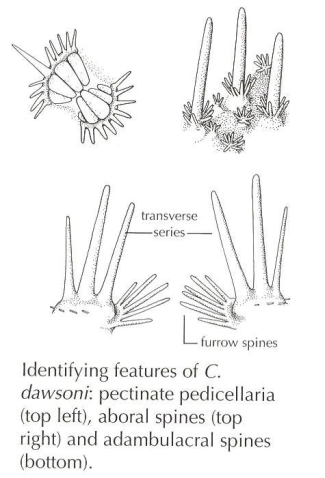Cheiraster dawsoni is a spiny vermilion sea star with five arms up to 17 cm long. The ratio of arm to disc is from 5.0 to 5.5. The larger aboral plates bear a large central spine surrounded at the base by a circle of 2 to 8 unequal spinelets; the smaller plates bear 1 to 12 spinelets. Papulae are absent from the centre of the disc, the aboral interradial area and the outer two-thirds of the arm; there are 3 to 8 pectinate pedicellariae on proximal half of each arm. The superomarginals and inferomarginals are staggered (not opposite each other). The superomarginals bear 2 stout tapering spines, and around each spine is a circle of 12 to 15 slender spinelets. The inferomarginals have 3 or 4 rigid tapering spines surrounded by auxiliary spinelets that are one-third the length of the spine. The oral interradial area has a few plates with small, well-spaced spinelets, 1 or 2 tapering spines and 1 to 3 pectinate pedicellariae. The adambulacrals are wider than their length; the curved furrow margin bears 4 to 7 spinelets, of which the central 3 or 4 are longer than the width of the plate; the oral surface has a transverse series of 2 or 3 long, slender spines, with a few spinelets around the edge. Mouth plates have 6 to 8 marginal spines, the apical spine being the largest, and 7 to 10 suborals.
Characteristics
Similar SpeciesAbove 200 metres depth, this species is very distinctive in shape and surface detail. In depths greater than 200 metres it might be confused with Nearchaster or Benthopecten species.
